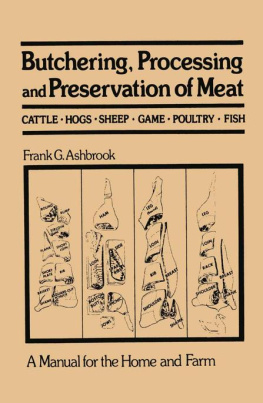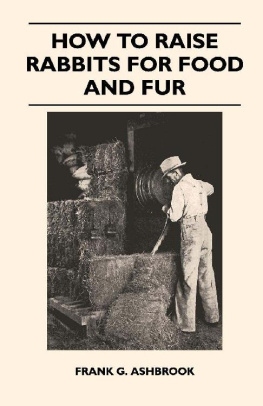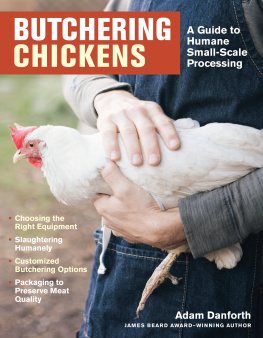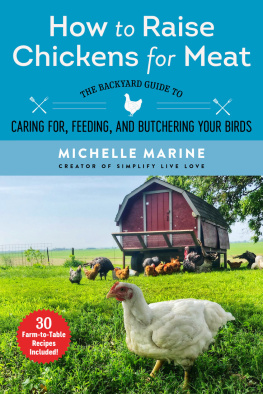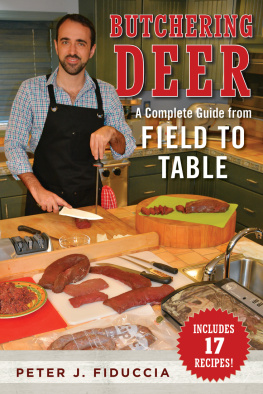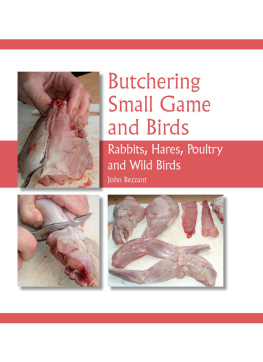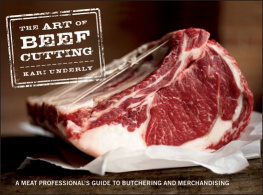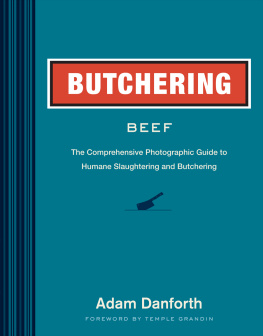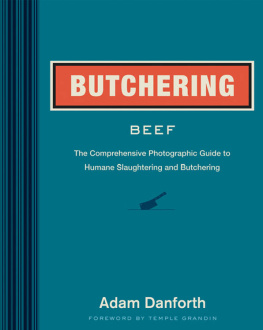This book is written primarily for the family to help solve the meat problem and to augment the food supply. Producing and preserving meats for family meals are sound practices for farm families and some city folks as wellthey make possible a wider variety of meats, which can be of the best quality, at less cost.
Meat is an essential part of the American diet. It is also an expensive food. With the costs high, many persons cannot afford to buy the better cuts; others are being forced to restrict the meat portion of the diet to a minimum, or to use ineffectual substitutes.
Commercially in the United States, meat means the flesh of cattle, hogs, and sheep, except where used with a qualifying word such as reindeer meat, crab meat, whale meat, and so on. Meat in this book is used in a broader sense, although not quite so general as to comprise anything and everything eaten for nourishment either by man or beast. To be sure, it includes the flesh of domestic animals and large and small game animals as well; also poultry, domestic fowl raised for their meat and eggs, and game birds, all wild upland birds, shore birds, and waterfowl; and fish.
Born in Pennsylvania, the author was reared in an atmosphere where custom dictated the utilization of plainer foods in the concocting of tasty dishes. In his grandmothers family, a German cook, with knowledge of old-world ways and customs, brought into the household a happy solution to many of the food problems which confront us even today.
The authors first introduction to some phases of the home processing of meats came when, as a very small boy, his grandfather put him to chopping and grinding meat, fat, and suet, and mixing these with other ingredients in making sausage, headcheese, scrapple ( ponhaws in Pennsylvania Dutch), and other meat concoctions.
Later, at the Pennsylvania State College as an animal husbandry student, he was taught by Professor W. H. Tomhave the scientific methods involved in dressing and curing meats.
After college, the author conducted research in swine production for the Federal Department of Agriculture at Beltsville, Maryland, and supervised the construction of an abattoir in which experimental hogs ran the gamut of slaughter, dressing, cooling, cutting, curing, and smoking. From this background and experience, the author expanded his research avocationally into the gastronomic art, to which he has been an ardent devotee throughout the years.
You who read this book may fall into one of the following categories: a livestock farmer specializing in cattle, hogs or sheep; a poultryman raising chickens, turkeys, ducks, geese, or guineas; a general farmer, keeping some livestock or poultry as a side line or for home consumption; a city or suburban dweller with a pen of chickens, pigeons, or rabbits in the back yard or lot; a person with a half interest in a pig, a lamb, or a calf that someone else is feeding until time for slaughter, and after dressing, a portion of the carcass is yours; a hunter who each season kills a deer, antelope, elk, moose, bear, or ducks, geese and upland game birds; a fisherman who frequently catches his limit; or you may be one of the more fortunate recipients from your generous friends who have an overabundance of good luck in the wild, and pass on to you a portion of their catch or kill.
Teachers and students in agricultural colleges, high schools, and vocational schools engaged in animal husbandry and home-economics studies will find the material in this book most helpful in their classroom and in their project work. All phases of the preparation of meat and meat products for home use, including slaughtering and dressing fresh and seasoned meat, cutting the carcass, refrigeration, curing, smoking, and canning, and the home tanning of hides and pelts are discussed in this book.
Carefully selected sources for those who desire more information than this book contains are given in the Appendix. This includes a list of publications issued by the United States Departments of Agriculture and the Interior, the State Game Departments, and reference books. Along with these, it seemed advisable to include a list of books that give methods and recipes for cooking all the meats discussed in this book. In addition, there is a directory of state agriculture experiment stations. Dont hesitate to ask your county agent for information and guidance.
A review was made of all recent scientific and practical literature in this field published in the United States, because the author believes it is not only desirable but essential that a book on practical meat economies be something more than a mere collection of ideas.
The author is especially grateful to the Agricultural Research Service, Agricultural Marketing Service, Federal Extension Service, and Forest Service, United States Department of Agriculture; to the Fish and Wildlife Service, United States Department of the Interior for material based on investigation and for permission to use photographs and drawings; also to the technical workers in the two federal departments for data and statistics obtained from research; to the Smithsonian Institution, Texas A. and M. College, Iowa State College, University of Missouri, and Pennsylvania State University for photographs and suggestions; to the Morton Salt Company and the National Livestock and Meat Board for material, including photographs and charts of wholesale and retail cuts of meat.
Sincere thanks are due to M. O. Cullen and Reba Staggs, National Livestock and Meat Board for charts, illustrations and data; to Professor J. H. Vondell, University of Massachusetts for photographs of cutting up a chicken, and to Dr. Jessop B. Low, Utah State College for illustrations of dressing wild ducks.
The preparation of this book has been a joint undertaking with Caroline McKinley Ashbrook who has contributed many constructive ideas and given valuable help and advice. Special acknowledgment is due Mary Ryan for suggestions of treatment, arrangement of material and splendid editing.
To all others who have lent material, called attention to special features, or aided with personal criticism or advice in the preparation of this book, the author desires to express appreciation and thanks.
Frank G. Ashbrook
Washington, D. C.

